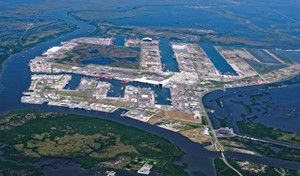PORT FOURCHON, OTHER GULF OIL FACILITIES LIKELY OFFLINE FOR WEEKS AFTER IDA
HOUSTON (Bloomberg) --Port Fourchon, America’s largest base supporting  the U.S. Gulf of Mexico offshore oil industry, will take weeks to recover after Hurricane Ida tore through the Louisiana community, leaving a wake of destruction in its path.
the U.S. Gulf of Mexico offshore oil industry, will take weeks to recover after Hurricane Ida tore through the Louisiana community, leaving a wake of destruction in its path.
“How many weeks is a good question,” Chett Chiasson, executive director of the Greater Lafourche Port Commission, said in an interview with National Public Radio that aired on Tuesday. “We have a long road ahead of us and there’s a lot of damage for us to assess and try to recover from.”
Damage to the port, which services about 90% of output from U.S. Gulf deepwater oil and natural gas wells, is extensive and widespread, he said. Louisiana Highway 1 will need to be cleared of debris for heavy equipment to travel south to the port, while navigable waters around the port will have to be surveyed for safe travel, he said.
In addition to power and water being out in the area, the workers themselves are also busy assessing their own home damage, Chiasson said.
“Many stayed, many left,” he said. “You have some facilities that are in pretty good shape -- maybe just some cosmetic damages and others that are completely destroyed.”
More than 250 companies working in the U.S. Gulf use Port Fourchon as a base of operations. It’s a key transit point for multiple crude pipelines that receive barrels produced from the Gulf of Mexico. From Fourchon, pipes head to hubs in Clovelly and St. James, which host large storage facilities and terminals.
The Louisiana Offshore Oil Port, a facility that receives crude flowing on pipes connected to offshore oil platforms, is also based at the Fourchon harbor. Known more commonly known as LOOP, it handles as much as 15% of the nation’s crude oil supply. It also operates a marine terminal, some 45 miles (72 kilometers) offshore that handles imports and exports of crude transported by tanker.
Beyond Port Fourchon itself, the oil-production platforms that are fixed at sea must also get workers flown back out via helicopter in order to restart operations. But even the helicopter companies are tied up evaluating their coastal facilities.
“Our crews will need to do some inventory over the next few days,” Adam Morgan, a spokesman for helicopter operator Bristow Group Inc., said Monday in an email. “It will be some time before we are in a position to provide any further updates.”
West Texas Intermediate, the U.S. oil benchmark, fell 32 cents to $68.89 a barrel at 11:46 a.m. in New York on Tuesday amid larger discussions of global crude supply. OPEC and its allies expect global oil markets will continue to tighten this year even as they revive output, but then flip into surplus again in 2022.
About 95% of oil production, and 94% of gas output had been shut-in as of Monday, according to the Bureau of Safety and Environmental Enforcement.
In the next couple of days Port Fourchon will have better information on what the true damages are, Chiasson said. But every day that that production remains shut is another day of limited fuel supplies, he said.
“Prices at the pump, fuel for vehicles, are going to go up because there’s no efficient services for the offshore oil and gas industry,” he said. “It’s certainly not back up and running.”




 Upload RFQ
Upload RFQ





 Twitter
Twitter Linkedin
Linkedin Facebook
Facebook YouTube
YouTube Sales@toplandoil.com
Sales@toplandoil.com +86 21-50890868
+86 21-50890868 Head Office: 8-1011,Lane 5600, Chuansha Road, Pudong, Shanghai, China
Head Office: 8-1011,Lane 5600, Chuansha Road, Pudong, Shanghai, China 